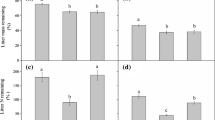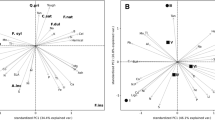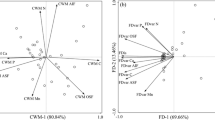Abstract
Plant litter decomposition is an essential ecosystem function in temperate streams. Both riparian vegetation and decomposer communities are major determinants of the decomposition efficiency and the interactions occurring within litter mixtures. However, the extent to which such litter mixture interactions are affected by combined shifts in litter traits and decomposer community is not well understood. We used leaf litter from 10 European tree species in order to study litter decomposition and litter mixture effects occurring in two-species litter mixtures in a temperate forested stream of northwestern France. The study distinguished between (1) decomposition involving microorganisms alone or together with invertebrates, and (2) decomposition involving litter mixtures of similar or dissimilar nutrient content. Increasing mean litter nutrient concentration favored both microbial activity and litter decomposition rate. Surprisingly, the highest litter mixture effects occurred in mixtures containing two nutrient-rich litters and occurred mainly in macroinvertebrate presence. Both the “mass ratio hypothesis,” expressed as the community-weighted mean traits (TraitCWM), and the “niche complementarity hypothesis,” expressed as the functional dissimilarity of litter traits (TraitFD), contributed to explain litter mixture effects. However, TraitCWM was found to be a better predictor than TraitFD. Finally, when evaluating the individual contributions of litter nutrients, calcium and magnesium appeared as important drivers of litter mixture effects. Our findings suggest that the mass ratio hypothesis overrules the niche complementarity hypothesis as a driver of litter diversity effects. Our study highlights the key importance of macroinvertebrates and of leaf nutrients, such as Ca and Mg, which are often neglected in decomposition studies in streams.






Similar content being viewed by others
References
Allan DJ. 1996. Stream Ecology. New York: Chapman and Hall.
Anderson JPE, Domsch KH. 1973. Quantification of bacterial and fungal contributions to soil respiration. Archiv für Mikrobiologie 93:113–27. https://doi.org/10.1007/BF00424942.
Anderson NH, Sedell JR. 1979. Detritus processing by macroinvertebrates in stream ecosystems. Annual Review of Entomology 24:351–77. https://doi.org/10.1146/annurev.en.24.010179.002031.
Botta Dukát Z. 2005. Rao’s quadratic entropy as a measure of functional diversity based on multiple traits. Journal of Vegetation Science 16:533–40. https://doi.org/10.1658/1100-9233(2005)16[533:RQEAAM]2.0.CO;2.
Boulton AJ, Boon PI. 1991. A review of methodology used to measure leaf litter decomposition in lotic environments: time to turn over an old leaf? Australian Journal of Marine Freshwater Resources 42:1–43. https://doi.org/10.1071/MF9910001.
Bruder A, Schindler MH, Moretti MS, Gessner MO. 2014. Litter decomposition in a temperate and a tropical stream: the effects of species mixing, litter quality and shredders. Freshwater Biology 59:438–449. https://doi.org/10.1111/fwb.12276.
Cadish G, Giller KE. 1997. Driven by Nature: Plant Litter Quality and Decomposition. Wallingford: CAB international.
Cairns A, Yan N. 2009. A review of the influence of low ambient calcium concentrations on freshwater daphniids, gammarids, and crayfish. Environmental Reviews 17:67–79. https://doi.org/10.1139/A09-005.
Cardinale BJ, Matulich KL, Hooper DU, Byrnes JE, Duffy E, Gamfeldt L, Balvanera P, O’connor MI, Gonzalez A. 2011. The functional role of producer diversity in ecosystems. American Journal of Botany 98:572–92. https://doi.org/10.3732/ajb.1000364.
Cornwell WK, Cornelissen JH, Amatangelo K, Dorrepaal E, Eviner VT, Godoy O, Hobbie SE, Hoorens B, Kurokawa H, Pérez-Harguindeguy N, Quested HM, Westoby M. 2008. Plant species traits are the predominant control on litter decomposition rates within biomes worldwide. Ecology letters 11:1065–71. https://doi.org/10.1111/j.1461-0248.2008.01219.x.
Cummins KW, Klug MJ. 1979. Feeding ecology of stream invertebrates. Annual review of ecology and systematics 10:147–72. https://doi.org/10.1146/annurev.es.10.110179.001051.
Cummins KW, Wilzbach MA, Gates DM, Perry JB, Taliferro WB. 1989. Shredders and riparian vegetation: Leaf litter that falls into streams influences communities of stream invertebrates. BioSciences 39:24–30. https://doi.org/10.2307/1310804.
Cummins KW. 2012. Structure and function of stream ecosystems. BioSciences 24:631–641. https://doi.org/10.2307/1296676.
Diaz S, Lavorel S, De Bello F, Quetier F, Grigulis K, Robson TM. 2007. Incorporating plant functional diversity effects in ecosystem service assessments. Proceedings of the National Academy of Sciences of the USA 104:20684–9. https://doi.org/10.1073/pnas.0704716104.
Epps KY, Comerford NB, Reeves JBIII, Cropper WP Jr, Araujo QR. 2007. Chemical diversity-highlighting a species richness and ecosystem function disconnect. Oikos 116:1831–40. https://doi.org/10.1111/j.0030-1299.2007.15853.x.
Ferreira V, Encalada AC, Graça MA. 2012. Effects of litter diversity on decomposition and biological colonization of submerged litter in temperate and tropical streams. Freshwater Science 31:945–62. https://doi.org/10.1899/11-062.1.
Fierer N, Craine JM, McLauchlan K, Schimel JP. 2005. Litter quality and the temperature sensitivity of decomposition. Ecology 86:320–6. https://doi.org/10.1890/04-1254.
Follstad Shah JJ, Kominoski JS, Ardón M, Dodds WK, Gessner MO, Griffiths NA, Hawkins CP, Johnson SL, Lecerf A, LeRoy CJ, Manning DW. 2017. Global synthesis of the temperature sensitivity of leaf litter breakdown in streams and rivers. Global Change Biology 23:3064–75. https://doi.org/10.1111/gcb.13609.
Foucreau N, Puijalon S, Hervant F, Piscart C. 2013. Effect of leaf litter characteristics on leaf conditioning and on consumption by Gammarus pulex. Freshwater Biology 58:1672–81. https://doi.org/10.1111/fwb.12158.
Frainer A, Moretti MS, Xu W, Gessner MO. 2015. No evidence for leaf-trait dissimilarity effects on litter decomposition, fungal decomposers, and nutrient dynamics. Ecology 96:550–61. https://doi.org/10.1890/14-1151.1.
Garcia-Palacios P, McKie BG, Handa IT, Frainer A, Hättenschwiler S. 2016. The importance of litter traits and decomposers for litter decomposition: a comparison of aquatic and terrestrial ecosystems within and across biomes. Functional Ecology 30:819–29. https://doi.org/10.1111/1365-2435.12589.
Garcia-Palacios P, Shaw EA, Wall DH, Hättenschwiler S. 2017. Contrasting mass-ratio vs. niche complementarity effects on litter C and N loss during decomposition along a regional climatic gradient. Journal of Ecology 105:968–78. https://doi.org/10.1111/j.1466-8238.2011.00651.x.
Garnier E, Cortez J, Billès G, Navas ML, Roumet C, Debussche M, Laurent G, Blanchard A, Aubry D, Bellmann A, Neill C, Toussaint JP. 2004. Plant functional markers capture ecosystem properties during secondary succession. Ecology 85:2630–7. https://doi.org/10.1890/03-0799.
Gessner MO, Chauvet E. 1994. Importance of stream microfungi in controlling breakdown rates of leaf litter. Ecology 75:1807–17. https://doi.org/10.2307/1939639.
Gessner MO, Chauvet E, Dobson M. 1999. A perspective on leaf litter breakdown in streams. Oikos 85:377–84. https://doi.org/10.2307/3546505.
Gessner MO, Swan CM, Dang CK, Mckie BG, Bardgett RD, Wall DH, Hättenschwiler S. 2010. Diversity meets decomposition. Trends in Ecology and Evolution 25:372–80. https://doi.org/10.1016/j.tree.2010.01.010.
Glazier DS. 1998. Springs as model systems for ecology and evolutionary biology: a case study of Gammarus minus Say (Amphipoda) in mid-Appalachian springs differing in pH and ionic content. In: Botosaneanu L, Ed. Studies in crenobiology: the biology of springs and springbrooks. Leiden: Backhuys Publishers. p 41–54.
Graça MAS. 2001. The role of invertebrates on leaf litter decomposition in streams-a review. International Review of Hydrobiology 86:383–93. 10.1002/1522-2632(200107)86:4/5<383::AID-IROH383>3.0.CO;2-D.
Grime JP. 1998. Benefits of plant diversity to ecosystems: immediate, filter and founder effects. Journal of Ecology 86:902–10. https://doi.org/10.1046/j.1365-2745.1998.00306.x.
Grimshaw HM, Allen SE, Parkinson JA. 1989. Nutrient elements. In: Allen SE, Ed. Chemical analysis of ecological materials. 2nd edn. Oxford: Blackwell Scientific. p 81–159.
Handa IT, Aerts R, Berendse F, Berg MP, Bruder A, Butenschoen O, Chauvet E, Gessner MO, Jabiol J, Makkonen M, McKie BG, Hättenschwiler S. 2014. Consequences of biodiversity loss for litter decomposition across biomes. Nature 509:218–21. https://doi.org/10.1038/nature13247.
Hättenschwiler S, Gasser P. 2005. Soil animals alter plant litter diversity effects on decomposition. Proceedings of the National Academy of Sciences 102:1519–1524. https://doi.org/10.1073/pnas.0404977102.
Hättenschwiler S, Tiunov AV, Scheu S. 2005. Biodiversity and litter decomposition in terrestrial ecosystems. Annual Review of Ecology, Evolution and Systematics 36:191–218. https://doi.org/10.1146/annurev.ecolsys.36.112904.151932.
Jabiol J, McKie BG, Bruder A, Bernadet C, Gessner MO, Chauvet E. 2013. Trophic complexity enhances ecosystem functioning in an aquatic detritus-based model system. Journal of Animal Ecology 82:1042–51. https://doi.org/10.1111/1365-2656.12079.
Jabiol J, Cornut J, Danger M, Jouffroy M, Elger A, Chauvet E. 2014. Litter identity mediates predator impacts on the functioning of an aquatic detritus-based food web. Oecologia 176:225–35. https://doi.org/10.1007/s00442-014-2990-y.
Jabiol J, Chauvet E. 2015. Biodiversity and litter decomposition: a case study in a Mediterranean stream. Freshwater Science 34:423–30. https://doi.org/10.1086/680094.
Jenkins CC, Suberkropp K. 1995. The influence of water chemistry on the enzymatic degradation of leaves in streams. Freshwater Biology 33:245–53. https://doi.org/10.1111/j.1365-2427.1995.tb01165.x.
Joyce P, Wotton RS. 2008. Shredder fecal pellets as stores of allochthonous organic matter in streams. Journal of the North American Benthological Society 27:521–8. https://doi.org/10.1899/07-102.1.
Kaspari M, Wright J, Yavitt J, Harms K, Garcia M, Santana M. 2008. Multiple nutrients limit litterfall and decomposition in a tropical forest. Ecology Letters 11:35–43. https://doi.org/10.1111/j.1461-0248.2007.01124.x.
Kominoski JS, Pringle CM, Ball BA, Bradford MA, Coleman DC, Hall DB, Hunter MD. 2007. Nonadditive effects of leaf litter species diversity on breakdown dynamics in a detritus-based stream. Ecology 88:1167–76. https://doi.org/10.1890/06-0674.
Krauss GJ, Solé M, Krauss G, Schlosser D, Wesenberg D, Bärlocher F. 2011. Fungi in freshwaters: ecology, physiology and biochemical potential. FEMS microbiology reviews 35:620–51. https://doi.org/10.1111/j.1574-6976.2011.00266.x.
Laughlin DC. 2011. Nitrification is linked to dominant leaf traits rather than functional diversity. Journal of Ecology 99:1091–9. https://doi.org/10.1111/j.1365-2745.2011.01856.x.
Lecerf A, Dobson M, Dang CK, Chauvet E. 2005. Riparian plant species loss alters trophic dynamics in detritus-based stream ecosystems. Oecologia 146:432–42. https://doi.org/10.1007/s00442-005-0212-3.
Lecerf A, Risnoveanu G, Popescu C, Gessner MO, Chauvet E. 2007. Decomposition of diverse litter mixtures in streams. Ecology 88:219–227. https://doi.org/10.1890/0012-9658(2007)88[219:DODLMI]2.0.CO;2.
Lecerf A, Marie G, Kominoski JS, LeRoy CJ, Bernadet C, Swan CM. 2011. Incubation time, functional litter diversity, and habitat characteristics predict litter-mixing effects on decomposition. Ecology 92:160–9. https://doi.org/10.1890/10-0315.1.
Leroy CJ, Marks JC. 2006. Litter quality, stream characteristics and litter diversity influence decomposition rates and macroinvertebrates. Freshwater biology 51:605–17. https://doi.org/10.1111/j.1365-2427.2006.01512.x.
Lummer D, Scheu S, Butenschoen O. 2012. Connecting litter quality, microbial community and nitrogen transfer mechanisms in decomposing litter mixtures. Oikos 121:1649–55. https://doi.org/10.1111/j.1600-0706.2011.20073.x.
Makkonen M, Berg MP, Handa IT, Hättenschwiler S, van Ruijven J, van Bodegom PM, Aerts R. 2012. Highly consistent effects of plant litter identity and functional traits on decomposition across a latitudinal gradient. Ecology Letters 15:1033–41. https://doi.org/10.1111/j.1461-0248.2012.01826.x.
Mokany K, Ash J, Roxburgh S. 2008. Functional identity is more important than diversity in influencing ecosystem processes in a temperate native grassland. Journal of Ecology 96:884–93. https://doi.org/10.1111/j.1365-2745.2008.01395.x.
National Research Council. 2005. Mineral Tolerance of Animals. 2nd edn. Washington: National Academic Press.
Petchey OL, Gaston KJ. 2006. Functional diversity: back to basics and looking forward. Ecology letters 9:741–58. https://doi.org/10.1111/j.1461-0248.2006.00924.x.
Piscart C, Genoel R, Dolédec S, Chauvet E, Marmonier P. 2009. Effects of intense agricultural practices on heterotrophic processes in streams. Environmental Pollution 157:1011–18. https://doi.org/10.1016/j.envpol.2008.10.010.
Piscart C, Navel S, Maazouzi C, Montuelle B, Cornut J, Mermillod-Blondin F, Creuse des Chatelliers M, Simon L, Marmonier P. 2011. Leaf litter recycling in benthic and hyporheic layers in agricultural streams with different types of land use. Science of the Total Environment 409:4373–80. https://doi.org/10.1016/j.scitotenv.2011.06.060.
Presa Abos C, Lepori F, McKie BG, Malmqvist B. 2006. Aggregation among resource patches can promote coexistence in stream-living shredders. Freshwater Biology 51:545–553. https://doi.org/10.1111/j.1365-2427.2006.01509.x.
Quested H, Eriksson O, Fortunel C, Garnier E. 2007. Plant traits relate to whole-community litter quality and decomposition following land use change. Functional Ecology 21:1016–26. https://doi.org/10.1111/j.1365-2435.2007.01324.x.
R Core Team. 2013. R: A Language and Environment for Statistical Computing. Vienna: R Foundation for Statistical Computing.
Ritz K. 2006. Fungal roles in transport processes in soils. In: Gadd MG, Ed. Fungi in biogeochemical cycles. Cambridge, UK: Cambridge University Press. p 51–73.
Sanpera-Calbet I, Lecerf A, Chauvet E. 2009. Leaf diversity influences in-stream litter decomposition through effects on shredders. Freshwater Biology 54:1671–82. https://doi.org/10.1111/j.1365-2427.2009.02216.x.
Santonja M, Baldy V, Fernandez C, Balesdent J, Gauquelin T. 2015a. Potential shift in plant communities with climate change in a Mediterranean Oak forest: consequence on nutrients and secondary metabolites release during litter decomposition. Ecosystems 18:1253–68. https://doi.org/10.1007/s10021-015-9896-3.
Santonja M, Fernandez C, Gauquelin T, Baldy V. 2015b. Climate change effects on litter decomposition: intensive drought leads to a strong decrease of litter mixture interactions. Plant and Soil 393:69–82. https://doi.org/10.1007/s11104-015-2471-z.
Santonja M, Pellan L, Piscart C. 2018a. Macroinvertebrate identity mediates the effects of litter quality and microbial conditioning on the leaf litter recycling in temperate streams. Ecology and Evolution 8:2542–53. https://doi.org/10.1002/ece3.3790.
Santonja M, Foucault Q, Rancon A, Gauquelin T, Fernandez C, Baldy V, Mirleau P. 2018b. Contrasting responses of bacterial and fungal communities to plant litter diversity in a Mediterranean oak forest. Soil Biology and Biochemistry 125:27–36. https://doi.org/10.1016/j.soilbio.2018.06.020.
Santschi F, Gounand I, Harvey E, Altermatt F. 2018. Leaf litter diversity and structure of microbial decomposer communities modulate litter decomposition in aquatic systems. Functional Ecology 32:522–32. https://doi.org/10.1111/1365-2435.12980.
Schimel JP, Hättenschwiler S. 2007. Nitrogen transfer between decomposing leaves of different N status. Soil Biology and Biochemistry 39:1428–36. https://doi.org/10.1016/j.soilbio.2006.12.037.
Schindler MH, Gessner MO. 2009. Functional leaf traits and biodiversity effects on litter decomposition in a stream. Ecology 90:1641–9. https://doi.org/10.1890/08-1597.1.
Srivastava DS, Cardinale BJ, Downing AL, Duffy JE, Jouseau C, Sankaran M, Wright JP. 2009. Diversity has stronger top-down than bottom-up effects on decomposition. Ecology 90:1073–83. https://doi.org/10.1890/08-0439.1.
Swan CM, Palmer MA. 2004. Leaf diversity alters litter breakdown in a piedmont stream. Journal of the North America Benthological Society 23:15–28.
Swan CM, Palmer MA. 2006a. Composition of speciose leaf litter alters stream detritivore growth, feeding activity and leaf breakdown. Oecologia 147:469–78. https://doi.org/10.1007/s00442-005-0297-8.
Swan CM, Palmer MA. 2006b. Preferential feeding by an aquatic consumer mediates non-additive decomposition of speciose leaf litter. Oecologia 149:107–14. https://doi.org/10.1007/s00442-006-0436-x.
Swan CM. 2011. Consumer presence and resource diversity independently induce stability of ecosystem function in a Piedmont stream. Ecosphere 2:136. https://doi.org/10.1890/ES11-00274.1.
Swift MJ, Heal OW, Anderson JM. 1979. Decomposition in terrestrial ecosystems. Berkeley: University of California press.
Vannote RL, Minshall GW, Cummins KW, Sedell JR, Cushing CE. 1980. The river continuum concept. Canadian Journal of Fisheries and Aquatic Sciences 37:130–7. https://doi.org/10.1139/f80-017.
Villanueva VD, Albarino R, Canhoto C. 2012. Positive effect of shredders on microbial biomass and decomposition in stream microcosms. Freshwater Biology 57:2504–13. https://doi.org/10.1111/fwb.12023.
Vos VC, van Ruijven J, Berg MP, Peeters ET, Berendse F. 2013. Leaf litter quality drives litter mixing effects through complementary resource use among detritivores. Oecologia 173:269–80. https://doi.org/10.1007/s00442-012-2588-1.
Wallace JB, Eggert SL, Meyer JL, Webster JR. 1997. Multiple trophic levels of a forest stream linked to terrestrial litter inputs. Science 277:102–4. https://doi.org/10.1126/science.277.5322.102.
Wardle DA, Bonner KI, Nicholson KS. 1997. Biodiversity and plant litter: Experimental evidence which does not support the view that enhanced species richness improves ecosystem function. Oikos 79:247–58. https://doi.org/10.2307/3546010.
Wetzel RG. 1995. Death, detritus, and energy flow in aquatic ecosystems. Freshwater Biology 33:83–9. https://doi.org/10.1111/j.1365-2427.1995.tb00388.x.
Acknowledgements
The chemical analyses were performed at the Plateforme d’Analyses Chimiques en Ecologie (PACE, LabEx Centre Méditerranéen de l’Environnement et de la Biodiversité, Montpellier, France), as well as at the PLateforme AnalYtique (PLAY, UMR CNRS 6553 ECOBIO, Rennes, France). We thank Raphaëlle Leclerc, Bruno Buatois, and Nicolas Barthes for technical assistance during the chemical analyses as well as Pierre Mariotte for his reviewing of the English. This study was funded by the Selune Project (Project Number 1 053 864) and by the Rennes Metropole’s Project AIS 2015. The study was also supported by the LTSER France Zone Atelier Armorique. Finally, the authors declare no conflict of interest.
Author information
Authors and Affiliations
Corresponding author
Electronic supplementary material
Below is the link to the electronic supplementary material.
Rights and permissions
About this article
Cite this article
Santonja, M., Rodríguez-Pérez, H., Le Bris, N. et al. Leaf Nutrients and Macroinvertebrates Control Litter Mixing Effects on Decomposition in Temperate Streams. Ecosystems 23, 400–416 (2020). https://doi.org/10.1007/s10021-019-00410-9
Received:
Accepted:
Published:
Issue Date:
DOI: https://doi.org/10.1007/s10021-019-00410-9




